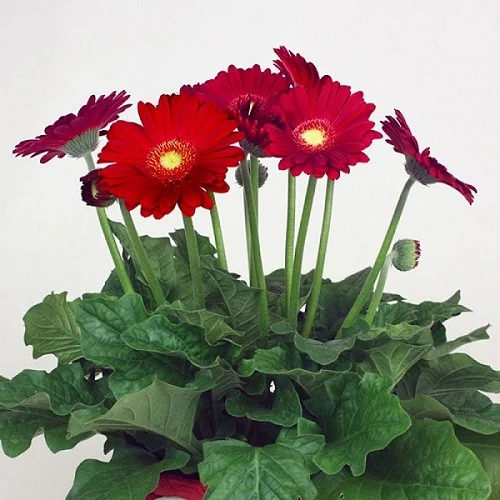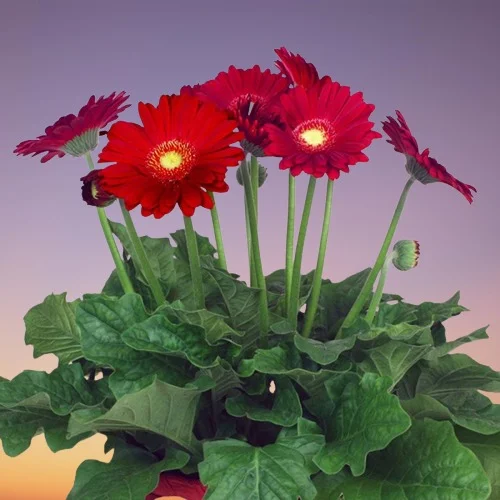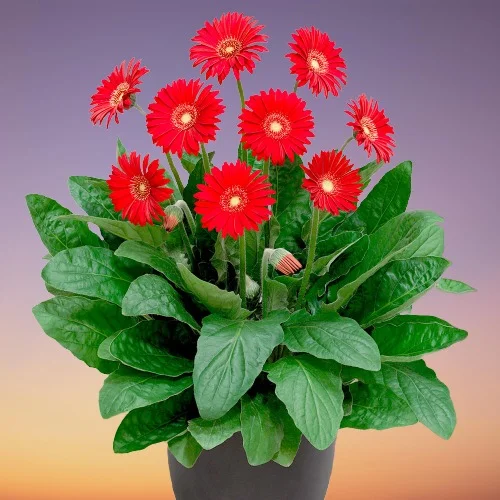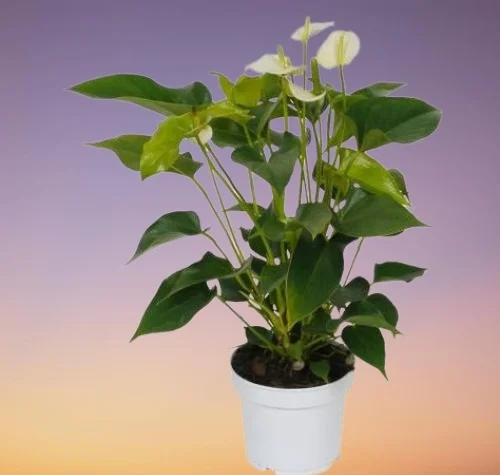Gerbera Daisy (Gerbera jamesonii) Common Problems and their Solutions
Some links in this post may be affiliate links
Gerbera Daisy (Gerbera jamesonii) common growing problems include yellow leaves, wilting and dying, leaf spots, mold, rotting, pests and diseases among others.
Gerbera Daisy also called Barbeton Daisy or Transvaal Daisy is among the popular flowering plants on account of its striking flowers that are a pleasant sight to behold in any space.
The flower colors come in soft pink, white, pale yellow, pink, orange, red and purple. They may be single flowers, semi-double flowers, double flowers, or spider flowers.
Transvaal Daisy is non-toxic to both humans and pets as indicated by ASPCA. It is also one of the best air-purifying plants which gets rid of formaldehyde and benzene as outlined on the NASA Clean Air Study.
As indicated by ASPCA, Gerbera Daisies are non-toxic to both humans and pets. They are some of the pet-safe plants for the home.
Barbeton Daisy performs best in bright light with 6-8 hours of direct sunlight, average warmth of 15-250C, moderate humidity of 50-55% and moderately moist, rich, well-drained, all purpose soil coupled with monthly feeding in the growing season. Read more on how to grow and care for Gerbera Daisy (Gerbera jamesonii) indoors.
If the right growing conditions are not provided, Gerbera Daisy may exhibit some problems. We have herebelow outlined some of the major problems. Keep reading to learn more.

Gerbera Daisy (Gerbera jamesonii) Problems and Treatment
1. Yellow leaves
There may be many causes of yellow leaves in Gerbera Daisy. We have discussed 5 of these causes herebelow.
- Too little light. Adequate light is required for photosynthesis, the process of food making in plants, which is needed for growth and energy for the plant.
Under inadequate lighting the plant cannot make adequate food for growth and development which causes the leaves to begin dying where they turn yellow, then brown and eventually die.
Position the Gerbera Daisy in a spot where it will receive bright light with 6-8 hours of direct sunlight or instal a grow light if the natural lighting is not enough. Check out these full spectrum grow lights on Amazon.
- Magnesium deficiency causes the leaves to turn yellow along the edges while the centers remain green.
Feed Gerbera Daisy every 3-4 weeks during the growing season with a water-soluble fertilizer that contains micro-nutrients like Iron, Zinc and Magnesium which are needed for the healthy growth of the plant.
- Iron deficiency causes gradual yellowing of the young leaves with the leaf veins retaining their green color.
The Iron deficiency is caused by unavailability of the nutrient to the plant at soil PH above 6.5. The best soil PH for Gerbera Daisy is between 5.5 and 6.5.
Spray the Gerbera Daisy with foliar chelated iron and feed it with an acidic fertilizer to correct the soil PH and keep it at the optimum level.
- Root-rot disease which is brought about by soggy soil due to poor quality soil and or lack of proper drainage.
Slip the plant out of its container and inspect the roots. Brown-black mushy roots indicate root-rot. Learn how to treat root-rot in houseplants.
- Pest infestations by sap-sucking insects like spidermites, aphids and scales cause wilting, reduced growth and yellowing of leaves.
Maintain the Gerbera Daisy well pruned by removing spent flowers, dead and yellow foliage to minimize pest infestations. Cut the leaves with a clean sharp knife or scissors as close to the base as possible.
Regularly inspect the plant for these pests and carry out timely control. Isolate the affected plant to reduce spread and treat it appropriately with an Insecticidal soap or neem oil to get rid of these pests. Make sure to follow the manufacturer's instructions.
Related: 15 Causes of Yellow Leaves in Indoor Plants and Their Fixes

2. Wilting and dying
We have herebelow discussed 3 reasons why Gerbera Daisy is wilting and dying.
- Underwatering. With too little moisture in the soil, the plant cannot get enough water needed for photosynthesis, therefore, the leaves loose their stiffness, they wilt and die.
Keep the soil moderately moist and never allow the soil ball to dry out completely. Apply water when the top 2-3 inches of soil are dry.
- Overwatering reduces oxygen needed in the soil to keep the roots alive. When the roots die, they cannot take up water from the soil into the plant. As such, it begins to wilt and eventually die if the situation is not corrected. Learn more on how to water indoor plants the right way.
Ensure that the soil for Gerbera Daisy is loose and free-draining and that the container in which it is growing has adequate drainage holes to prevent the soil from getting soggy. Take a look at these self watering pots on Amazon.
- Spidermites infestation. These insects suck the plant sap which causes dehydration of the plant resulting in wilting and possibly death.
Keep the plant well pruned, regularly inspect the plant for signs of webbing under the leaves and carry out timely control of these pests.
Related: 10 Reasons Why Gerbera Daisy is Dying and How to Revive It
3. Gerbera Daisy Pests
The common pests in Gerbera Daisy are aphids, scales, spidermites, fungus gnats and caterpillars. These sap-sucking pests will cause wilting, reduced growth and yellowing of leaves.
Isolate the affected plant to prevent spread to other houseplants and treat it with appropriate products like Neem oil or insecticidal soap as per the manufacturer's instructions.

4. Gerbera Daisy Diseases
(a) Leaf spot disease
Leaf spot disease is characterized by brown leaf spots surrounded by lighter-colored borders. In a serious attack the spots can enlarge and merge, killing the whole leaf. The disease is prevalent in stuffy humid conditions.
Treatment and Solutions
Remove and burn the affected leaves to reduce the risk of spread to the rest of the plant and other houseplants.
Spray the affected plant with a systemic fungicide and ensure that all the parts of the plant are completely covered with the fungicidal solution.
Improve on ventilation and allow good air circulation around the plant to minimize the occurence of the disease.
(b) Powdery mildew
Powdery mildew is characterized by moldy leaves and flowers which is enhanced by overwet conditions coupled with poor air circulation. The disease results in disfigured leaves and in severe cases it can spread to the stems of the plant.
Treatment and Solutions
Cut off the diseased parts to minimze spread and keep the plant warm while ensuring that there is good air circulation
Spray the plant with a systemic fungicide. Ensure all the parts of the plant are completely covered with the fungicidal solution.
Do not mist the plant as moisture on the foliage creates favorable conditions for the disease.
(c) Botrytis disease
botrytis disease is characterized by grey, fluffy mould which can cover all parts of the plant; leaves, stems, buds and flowers.
The disease is caused by the fungus by the name, Botrytis cinerea and is prevalent where the growing conditions are cool and humid with no air circulation.
Treatment and Solutions
Cut all affected plant parts and destroy by burning to prevent spread to the entire plant and other houseplants. Remove and replace the moldy soil with fresh, loose, free-draining soil and allow the soil to dry out between waterings.
Spray the plant with a systemic fungicide. Ensure all the parts of the plant are well covered with the fungicidal solution.
Maintain the soil on the drier side; reduce watering to keep the soil moderately moist and ensure that the pot has a draiange hole. Improve ventilation for the plant and ensure that there is free air circulation to discourage the disease infestation.
(d) Crown-rot disease
Limp leaves and rotten crown center in Gerbera Daisy are an indication of crown-rot disease due to wetting of the crown during watering.
Crown-rot disease is a fungal disease which spreads rapidly and kills the plant with no intervention. It is common in wet, cool and poorly ventilated plant growing conditions.

Treatment and Solutions
If caught early, the disease can be treated but if it has spread, the plant cannot be saved and it should be discarded. To save a plant that is in the early stages of infestation, cut away and discard or burn the diseased tissue.
Keep the soil on the drier side; avoid soggy soil by ensuring that the soil is free-draining and the pot has a drainage hole.
Ensure there is free air circulation for your plant. Avoid keeping your plant in too cold conditions. Avoid wetting the crown of the plant during watering or water it from the bottom instead.
If the plant is too far gone, discard or burn it. Discard its pot and the soil as the treatment is not effective and may spread to the rest of the houseplants.
(e) Root-rot disease
The first sign of root-rot disease is yellowing and wilting of the leaves which is rapidly followed by browning and plant collapse.
The cause of root-rot disease is a fungal decay which is promoted by soggy soil. Always ensure that the soil is free-draining soil and that the pot has a drainage hole.
Treatment and Solutions
Do not let water stand in the saucer for too long. Empty the saucer so that the plant does not sit on water after you are done watering. This will prevent water from standing too long in the potting mix when you water the plant and thus prevent the soil from getting soggy.
If spotted early, root-rot disease can be treated and the plant can be saved. The best treatment for root-rot disease is through root surgery technique as follows.
Take the plant out of its pot, wash the soil away from the roots. Cut away any stems or leaves showing any signs of rot. Cut off brown-black, mushy roots.
Disinfect the remaining roots and the entire plant with a copper-based fungicidal solution. Ensure that the entire plant is
Disinfect the pot with the fungicidal solution or use a fresh pot and repot the plant in fresh potting soil. Ensure that the soil is free-draining and the pot has a drainage hole to prevent the soil from getting soggy.
Water the plant with the fungicidal solution and place the pot in a well-lit spot. Do not water the plant again until new growth appears and avoid overwatering and soggy soil thereafter.
However, ff all the roots are brown-black and mushy, the plant is far gone and cannot be saved. Discard the plant and disinfect the pot with a fungicidal solution before re-using it.
(f) Viral infections
Viral infections in Gerbera Daisy are indicated by stunted plant growth, distorted stems, pale green or yellow spots or small patches on the leaves and large white streaks on the flowers.
Treatment and Solutions
These viral diseases are transmitted by sap-sucking plant insect pests like aphids, spidermites and scales. Therefore, to prevent infestation and spread, carry out timely control of these insects.
There is no cure for these infections. The best option is discard the infected plant to reduce spread of the diseases in your houseplants collection.
You liked it? Share on social media.
Related Content
Amazon Associates Disclosure
Homeplantsguide.com is a participant in the Amazon Services LLC Associates Program, an affiliate advertising program designed to provide a means for sites to earn advertising fees by advertising and linking to amazon.com.

